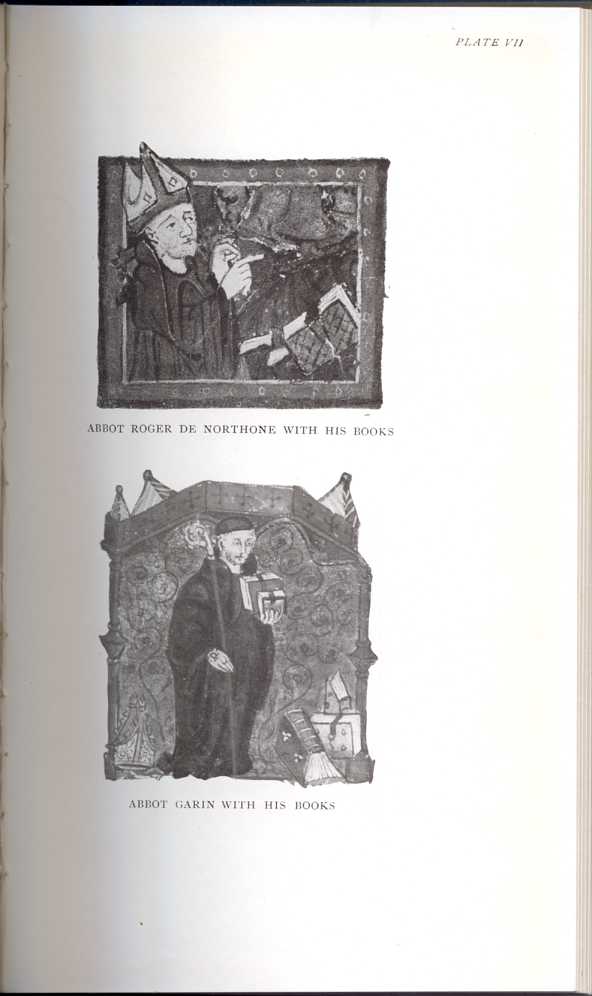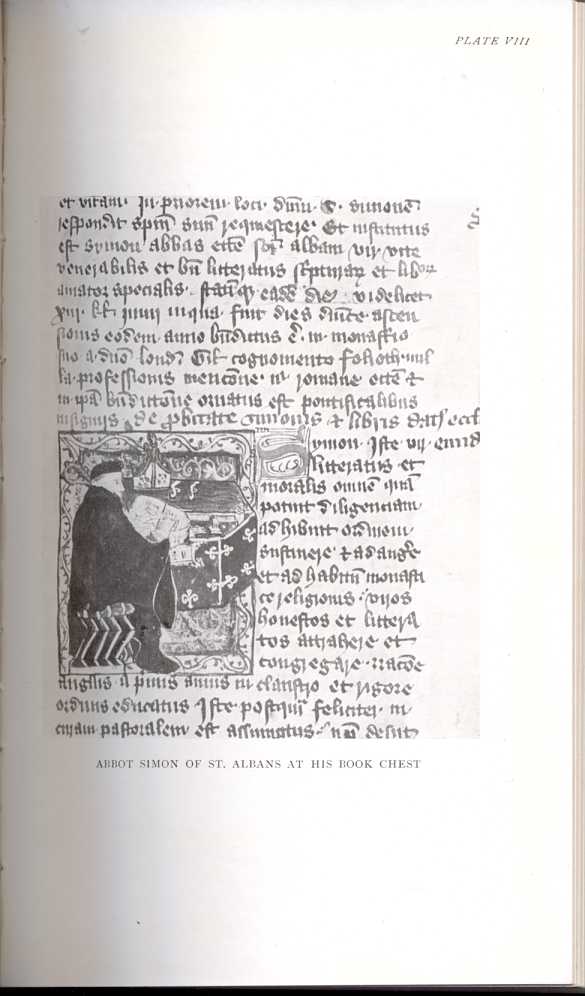| CHAPTER III: LIBRARIES OF THE GREAT ABBEYS—BOOK-LOVERS AMONG THE
MENDICANTS—DISPERSAL OF MONKISH LIBRARIES Old English libraries; the making, collection and use of books during the middle ages | ||
1. § I
THE Conquest wrought both good and evil to literature —evil because the Normans thought books written in the vernacular unworthy of preservation;[3.1] good because the change brought to the country settled government, and to the church an opportunity for reformation. Lanfranc was the moving spirit of reform, both in church administration and in the learning of its members. While still in Normandy he had built up a reputation for the monastic school at Bec, and probably had a share in collecting the excellent library that we know the monastery possessed in the twelfth century. [3.2] When he was appointed to the see of Canterbury he continued to work for the same
Lanfranc also encouraged original composition, for Osbern, monk of Canterbury, compiled his lives of St. Dunstan, St. Alphege, and St. Odo under his eye.
In this work of bookmaking and collecting Lanfranc was supported or his example was followed by other monks from Normandy: by Abbot Walter of Evesham, who made many books;[3.6] by Ernulf of Rochester, who compiled the Textus Roffensis; and by many others. At this time grew up the practice of using English houses to supply books for Norman abbeys; this partly explains the number of manuscripts of English workmanship now abroad. A manuscript preserved in Paris contains a note by a canon of Ste-Barbe-en-Auge referring to Beckford in Gloucestershire, an English cell of his house, whence books were sent to Normandy.[3.7]
From Lanfranc to the close of the thirteenth century, was the summer-time of the English religious houses. The
During this prosperous age some of the great houses did their
best work in writing and study. Thus to pick out one or two facts from a
string of them. In 1104 Abbot Peter of Gloucester gave many books to the
abbey library. In 1180 the refounded abbey of Whitby owned a fair
library of theological, historical, and classical books.
[3.10] About the same time Abbot Benedict ordered
the transcription of sixty volumes, containing one hundred titles, for
his library at Peterborough.[3.11] By 1244,
in spite of losses in the fire of 1184, Glastonbury had a library of
some four hundred volumes, historical books consorting with romances,
Bibles and patristical works almost crowding out some forlorn
classics.[3.12] Nearly half a century later
 [Description: ABBOT ROGER DE NORTHONE WITH HIS BOOKS;
ABBOT GARIN WITH HIS BOOKS]
[Description: ABBOT ROGER DE NORTHONE WITH HIS BOOKS;
ABBOT GARIN WITH HIS BOOKS]
To such facts as these should be added the record of the Canterbury, Dover, and Bury libraries, the histories of which have been so admirably written by Dr. M. R. James. [3.15] Of the library of St. Albans Abbey we have not such a fine series of catalogues. Yet no abbey could have a nobler record. From Paul (1077) to Whethamstede (d. 1465) nearly all its abbots were book-lovers.[3.16] Paul built a writing-room, and put in the aumbries twenty-eight fine books (volumina notabilia), and eight Psalters, a Collectarium, books of the Epistles and Gospels for the year, two copies of the Gospels adorned with gold and silver and precious stones, without speaking of ordinals, customaries, missals, troparies, collectaria, and other books. Here, as everywhere, the library began with church books: later, easier circumstances made the stream of knowledge broader, if shallower. The next abbot also added some books. Geoffrey, the sixteenth abbot, was the author of a miracle play, an industrious scribe, and the donor of some books finely illuminated and bound. His successor, at one time the conventual archivist, loved books equally well, and got together a fair collection. Great Abbot Robert had many books written—"too many
John, worthy follower of Simon, was a man of learning, who added
many noble and useful books to St. Albans' store. William of Trompington
(1214) distinguished himself by giving to the abbey books he had taken
from his prior. Abbot Roger was a better man, and gave many books and
pieces; but John III and IV and Hugh are barren rocks in our fertile
valley, for apparently they did nothing for the library. Richard of
Wallingford did worse than nothing. He bribed Richard de Bury with four
volumes, and sold to him thirty-two books for fifty pounds of silver,
retaining one-half of this sum for himself, and devoting the other
moiety to Epicurus—"a deed," cries the chronicler, "infamous to all who
agreed to it, so to make the only nourishment of the soul serve the
belly, and upon any account to apply spiritual dainties to the demands
of the flesh."[3.18] Abbot Michael de
Mentmore, who had been educated at Oxford, and became schoolmaster at
St. Albans, encouraged the educational work of the abbey by making
 [Description: ABBOT SIMON OF ST. ALBANS AT HIS BOOK
CHEST]
[Description: ABBOT SIMON OF ST. ALBANS AT HIS BOOK
CHEST]
But Whethamstede was St. Albans' greatest book-loving abbot. An ardent book-lover, especially fond of finely-illuminated volumes, he indulged his passion for manuscripts, and for conventual buildings, vestments, and property, until he got the abbey into debt, and was led to resign. After the death of his successor, Whethamstede was re-elected. In his time no fewer than eighty-seven volumes were transcribed.[3.19] In 1452-53 he built a new library at a cost of more than £150. Another library was erected for the College of the Black Monks at Oxford, for £60. [3.20] It was described as a "new erection of a library joyning on the south-side of the chapel, containing on each side five or more divisions, as it may be partly seen to this day by the windows thereof, to which he gave good quantity of his own study, and especially those of his own composition, which were not a few, and to deter plagiaries and others from abusing of them, prefixt these verses in the front of every one of the same books, as he did also to those that he gave to the publick library of the University:
Per patrem pecorum prothomartyris Angligenarum;
Quem, si quis rapiat raptim, titulumve retractet,
Vel Judae laqueum, vel furcas sentiat; Amen
"In other books which he gave to the said library these:
Culta magisque Deae datur hic fiber ara Minervae,
His qui Diis dictis libant holocausta ministris
Et circa bibulam sitinnt prae nectare limpham
Estque librique loci, idem dator, actor et unus." [3.21]
This, in brief, is the story of St. Albans' tribute to learning. In most monasteries the same kind of work went on, in a more circumscribed fashion, and without the same distinction of finish, which could probably only be attained at the big places where expert scribes and illuminators could be well trained.[3.22]
| CHAPTER III: LIBRARIES OF THE GREAT ABBEYS—BOOK-LOVERS AMONG THE
MENDICANTS—DISPERSAL OF MONKISH LIBRARIES Old English libraries; the making, collection and use of books during the middle ages | ||